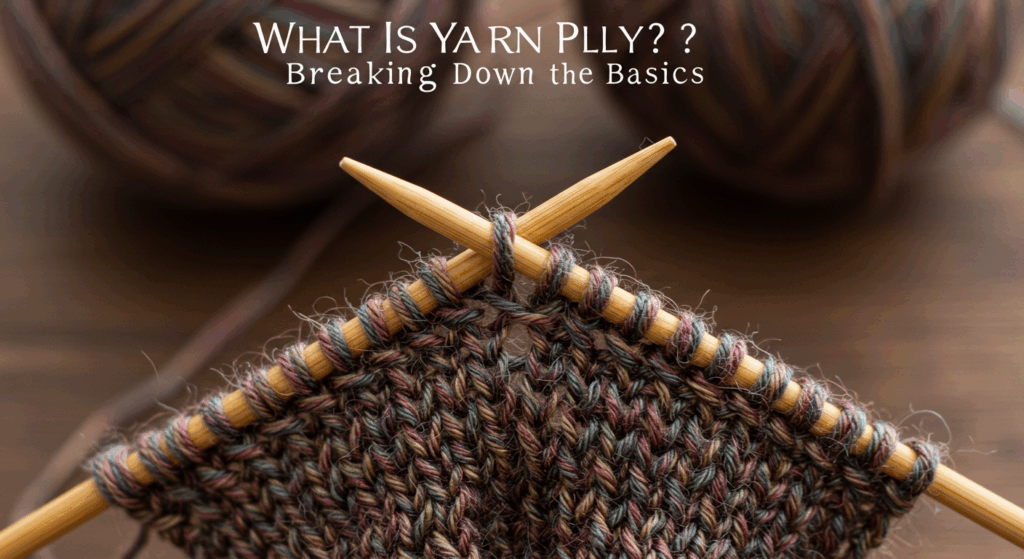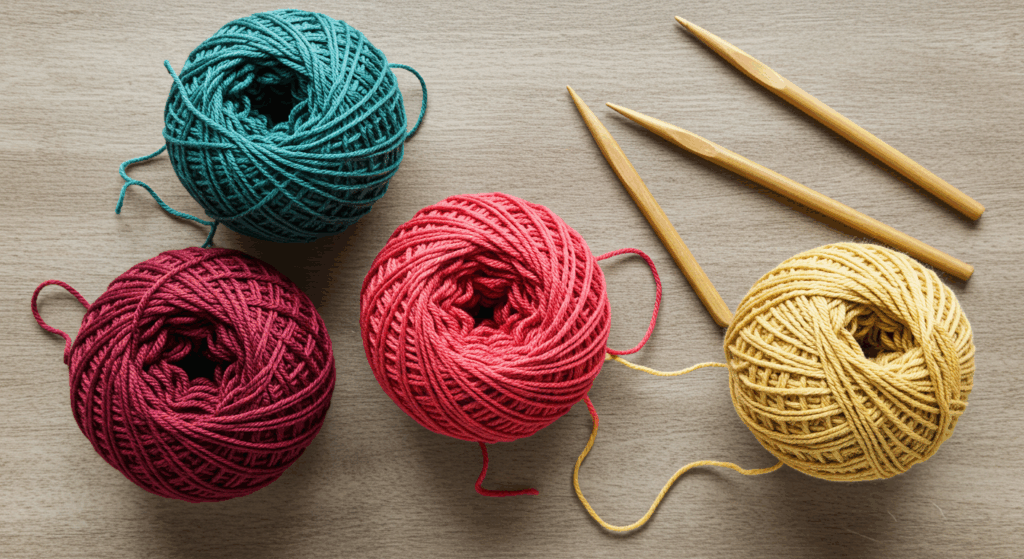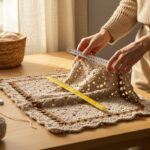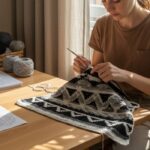Introduction
Have you ever picked up two skeins of yarn that looked almost identical—same color, same fiber, similar weight—but when you started crocheting, one felt stronger, smoother, and produced a completely different fabric than the other? Chances are, the difference came down to yarn ply—a detail many crocheters overlook, but one that can make or break your project.
Yarn ply refers to the number of individual strands twisted together to form a single strand of yarn. It might sound like a technical detail reserved for textile experts, but in reality, understanding ply can transform your crochet experience. Whether you’re crafting a cozy blanket, a delicate shawl, or a sturdy tote bag, the ply of your yarn influences everything from drape and durability to stitch definition and texture.
In this article, we’ll demystify yarn ply and explore how strand count affects your crochet projects. You’ll learn how to identify ply, why it matters in different types of projects, and how to choose the right ply for the look and feel you want. We’ll also share practical tips, real-life examples, and simple ways to test yarns so you can make smarter choices every time you shop.
By the end, you won’t just see yarn differently—you’ll feel it differently. So grab your favorite hook, settle in, and let’s unravel the world of yarn ply together.
What Is Yarn Ply? Breaking Down the Basics

Let’s start with the fundamentals: What exactly is yarn ply?
Imagine taking several thin strands of fiber—like cotton, wool, or acrylic—and twisting them tightly together. The resulting single strand is what we call plied yarn, and each individual strand is known as a ply. A 2-ply yarn has two strands twisted together; a 4-ply has four, and so on.
Now, here’s where it gets interesting: ply doesn’t always correspond directly to yarn weight. You can have a bulky 3-ply yarn or a fine 6-ply lace weight. That’s because ply is about construction, not thickness. The same fiber can be spun into different plies to create different textures and strengths.
For example:
- A 2-ply merino wool might be soft and slightly fuzzy, perfect for a lightweight scarf.
- A 4-ply version of the same wool could be smoother, stronger, and better suited for a sweater or baby blanket.
Ply affects how the yarn behaves when you crochet. Higher ply yarns tend to be more durable because the multiple strands support each other, reducing the chance of breakage. They also often have better stitch definition—meaning your crochet patterns look crisper and more defined.
But here’s a common misconception: More plies don’t automatically mean thicker yarn. A 4-ply cotton might actually be thinner than a bulky 2-ply acrylic, depending on how the fibers were spun. That’s why it’s so important to look beyond the ply number and consider fiber content, twist tightness, and overall texture.
So, when you’re standing in the craft store or browsing online, don’t just glance at the ply and assume you know what you’re getting. Instead, feel the yarn, stretch it gently, and look closely at how the strands are twisted. These small observations can tell you more than any label ever could.
Understanding ply is the first step toward becoming a more intentional crocheter—one who chooses materials not just by color or price, but by how they’ll perform in your project.
Why Ply Matters: Strength, Durability, and Stitch Definition
Now that we know what ply is, let’s talk about why it really matters in your crochet work.
One of the most important benefits of higher ply yarns is increased strength and durability. Think of it like a rope: a single strand breaks easily, but twist several strands together, and you’ve got something much harder to snap. The same principle applies to yarn.
When you crochet with a 4-ply or 6-ply yarn, you’re building a fabric that can withstand more wear and tear. This is especially important for items that get heavy use—like dishcloths, baby clothes, or market bags. A single-ply yarn might pill or fray over time, while a well-plied yarn holds up beautifully.
But strength isn’t the only advantage. Stitch definition is another key factor influenced by ply.
Have you ever worked a beautiful lace pattern, only to find that the stitches blurred together and lost their shape? That could be due to low ply or loose twist. Multi-ply yarns, especially those with a tight twist, help your stitches stand out clearly. Each loop is crisp, each cluster well-defined—perfect for intricate patterns like cables, bobbles, or filet crochet.
On the flip side, lower ply yarns (like 1-ply or 2-ply) often have a softer, more rustic look. They can create a lovely halo or fuzziness, which is great for cozy cowls or dreamy shawls. However, they may not hold their shape as well over time, especially if they’re not blocked properly.
Let’s look at a real-life example:
- Project: A baby blanket
- Yarn A: 2-ply merino (soft but delicate)
- Yarn B: 4-ply cotton blend (strong and smooth)
While Yarn A feels dreamy in your hands, it may pill after repeated washing. Yarn B, though slightly less fluffy, will resist pilling, maintain its shape, and survive countless laundry cycles. For a baby blanket, durability is key—so Yarn B is the smarter choice.
The takeaway? Ply affects both the look and the lifespan of your project. By matching the ply to your project’s needs, you’re not just crocheting—you’re engineering something meant to last.
Ply vs. Weight: Untangling the Confusion
Here’s a question that trips up even experienced crocheters: Is ply the same as yarn weight?
Short answer: No.
Yarn weight refers to how thick the yarn is—categories like lace, fingering, worsted, or bulky. Ply refers to how many strands are twisted together. While they’re related, they’re not interchangeable.
In some countries, like the UK, people used to refer to “4-ply” as a specific weight—roughly equivalent to fingering or sport weight. But that label is more about tradition than accuracy. Today, you can find 4-ply yarns in everything from lace to aran weights.
For example:
- A 4-ply silk yarn might be as fine as thread, perfect for delicate shawls.
- A 4-ply alpaca blend could be bulky and warm, ideal for a winter hat.
So what should you rely on instead?
The Craft Yarn Council’s Standard Yarn Weight System is your best friend. It uses numbers 0 to 7 to classify yarn thickness:
- 0: Lace
- 1: Super Fine (fingering)
- 2: Fine (sport)
- 3: Light (DK)
- 4: Medium (worsted)
- 5: Bulky
- 6: Super Bulky
- 7: Jumbo
This system is based on wraps per inch (WPI) and recommended hook sizes, making it much more reliable than ply labels.
Here’s a helpful tip: Always check the label for both weight category and ply. If a yarn is labeled “4-ply” but falls under Category 5 (Bulky), don’t assume it’s light just because of the ply number.
And if you’re buying yarn without a label—like from a local artisan or a mystery stash find—use a WPI gauge. Wrap the yarn around a pencil 10 times, measure the width in inches, and divide 10 by that number. This gives you wraps per inch, which you can match to the standard chart.
Understanding the difference between ply and weight helps you avoid frustration. No more starting a sweater only to realize your “4-ply” yarn is actually too thick for the pattern!
How Ply Affects Drape and Texture in Your Projects
Beyond strength and stitch definition, ply plays a big role in how your finished piece feels and moves—in other words, its drape and texture.
Drape refers to how fluidly a fabric hangs or flows. A stiff yarn creates a structured piece, while a soft, flexible yarn drapes elegantly over the body. Ply influences this in subtle but powerful ways.
Higher ply yarns with a tight twist tend to be more structured. They hold their shape well, making them ideal for bags, hats, or amigurumi. The multiple strands resist stretching, so your stitches stay crisp and defined.
Lower ply yarns, especially single-ply, are often softer and more fluid. They drape beautifully, making them perfect for shawls, scarves, or garments meant to flow. However, because they’re less twisted, they can stretch out over time—especially when worn or washed.
Let’s compare two popular yarn types:
- Single-ply merino: Ultra-soft with a slight halo, but stretches easily. Great for cozy wraps, but not ideal for items needing shape retention.
- 3-ply sock yarn: Strong, springy, and resistant to wear. Perfect for socks or mittens that need to endure friction.
Texture is another consideration. Multi-ply yarns often feel smoother and more uniform. Single-ply yarns may feel slightly uneven or “handmade,” which some crafters love for its artisanal charm.
Pro Tip: If you want both softness and durability, look for plied yarns made from fine fibers—like 4-ply cashmere blends or 3-ply silk-wool mixes. These give you the best of both worlds: luxurious drape with reliable strength.
And don’t forget about colorwork! Tightly plied yarns handle stranded crochet better because the strands don’t snag or split as easily. For Fair Isle or tapestry crochet, a 3- or 4-ply yarn can make your project much smoother to work.
Choosing the right ply for drape and texture means your project doesn’t just look good—it feels right in your hands and on your body.
Choosing the Right Ply for Different Projects: A Practical Guide
Now that we’ve covered the theory, let’s get practical. How do you choose the right ply for your next project?
Here’s a simple guide to help you match ply to purpose:
1. Baby Items & Everyday Wear (4-ply recommended)
- Think blankets, booties, and sweaters.
- You want something soft, durable, and easy to wash.
- A 4-ply cotton or cotton-acrylic blend offers strength without sacrificing comfort.
- Bonus: Higher ply resists pilling, so the item stays looking new.
2. Shawls & Scarves (2-ply to 4-ply, depending on drape)
- For lightweight, flowing pieces: Try a 2-ply lace yarn.
- For more structure: Go with a 4-ply fingering weight.
- Wool-silk blends in 3-ply are excellent for elegant drape and sheen.
3. Bags & Home Goods (4-ply or higher)
- Tote bags, baskets, and coasters need to withstand stress.
- Choose tightly plied cotton or linen blends.
- 6-ply yarns (like some rug wools) are excellent for heavy-duty items.
4. Socks & Gloves (3-ply or 4-ply with nylon)
- Socks take a beating, so durability is key.
- Most commercial sock yarns are 4-ply with 20–25% nylon for reinforcement.
- The ply helps the yarn resist abrasion from shoes and friction.
5. Amigurumi & Toys (4-ply worsted weight)
- You need tight stitch definition and shape retention.
- A smooth 4-ply acrylic or cotton works best.
- Avoid single-ply—it can split easily when sewing parts together.
6. Lace & Delicate Projects (2-ply or 3-ply)
- Fine plies allow for intricate stitchwork without adding bulk.
- Silk or bamboo blends in 2-ply create stunning, lightweight fabrics.
Quick Decision-Making Tip: Ask yourself:
- Will this item be washed often? → Choose higher ply.
- Do I want it to drape or hold shape? → Lower ply for drape, higher for structure.
- Is it for a child or pet? → Prioritize durability with 4-ply or more.
By aligning your ply choice with your project’s needs, you’ll spend less time fixing mistakes and more time enjoying your finished piece.
Common Myths About Yarn Ply—Debunked
Even seasoned crafters fall for common myths about yarn ply. Let’s clear up some misconceptions:
Myth #1: More plies always mean better quality. Not true. A poorly spun 6-ply yarn can feel rough and uneven, while a well-made 2-ply can be luxurious. Quality depends on fiber, spin, and finishing—not just ply count.
Myth #2: Single-ply yarn is weak and useless. False. Single-ply yarns have their place—especially in art yarns, rustic knits, or projects where softness is key. They just require careful handling and aren’t ideal for high-wear items.
Myth #3: Ply determines yarn weight. As we’ve discussed, this is outdated. Always check the weight category, not just the ply number.
Myth #4: You can’t crochet with lace-weight 2-ply yarn. You absolutely can! With a small hook and patience, lace-weight plied yarns create stunning shawls and heirloom pieces. Just make sure your tension is even.
Myth #5: All 4-ply yarns are the same. Far from it. One 4-ply cotton might be stiff and smooth; another 4-ply wool could be fluffy and elastic. Always swatch and test before committing to a large project.
The truth is, ply is a tool—not a rule. It’s one factor among many, including fiber content, twist, dye lot, and personal preference.
Instead of chasing the “perfect” ply, focus on what works for your project and your hands. Some crocheters love the smoothness of high-ply yarns; others prefer the organic feel of single-ply. There’s no right or wrong—just what feels right for you.
How to Test Yarn Ply at Home: Simple DIY Methods
You don’t need a lab to figure out a yarn’s ply. Here are three easy ways to assess ply at home:
1. The Untwist Test
- Cut a 6-inch strand from your yarn.
- Carefully untwist one end.
- Count how many individual strands come apart.
- That’s your ply count!
- Note: Be gentle—some yarns are tightly spun and may resist untwisting.
2. The Visual Inspection
- Hold the yarn up to a bright light.
- Look closely at the surface.
- You’ll often see the individual plies spiraling around each other.
- Smooth, even spirals suggest good ply; uneven or loose twists may indicate lower quality.
3. The Stretch Test
- Gently pull a strand between your fingers.
- A multi-ply yarn will stretch slightly and spring back.
- A single-ply may stretch more and not recover as well.
- If it breaks easily, it might be weak or poorly spun.
These tests are especially useful when buying from indie dyers, thrift stores, or mystery yarns. They help you make informed decisions before investing time and effort into a project.
And here’s a bonus tip: Keep a yarn journal. Note the ply, fiber, and how it performed in your project. Over time, you’ll build a personal reference guide that saves you guesswork.
The Future of Yarn: Innovation in Ply and Sustainability
As crocheters, we’re not just making things—we’re part of a larger movement toward sustainable, thoughtful crafting.
Modern yarn makers are reimagining ply for both performance and planet. Innovations include:
- Recycled plied yarns made from post-consumer materials.
- Regenerative wool spun into durable 3- and 4-ply yarns.
- Plant-based blends (like hemp-cotton) with improved twist and strength.
Some brands are even experimenting with variable ply—yarns that shift ply count along the strand to create texture and visual interest. Imagine crocheting a scarf that naturally transitions from smooth to nubby, all in one skein!
Sustainability also ties into ply choice. Durable, high-ply yarns last longer, reducing the need for replacements. A well-made 4-ply sweater can be handed down for generations—true slow fashion.
And let’s not forget local yarns. Supporting small dyers and spinners often means getting unique, hand-plied yarns that support ethical labor and eco-friendly practices.
As crafters, our choices matter. By understanding ply, we can choose yarns that are not only beautiful but responsible.
Conclusion: Mastering Ply for Better Crochet
We’ve come a long way from that simple question: What is yarn ply? Now, you know it’s much more than a number on a label—it’s a key to unlocking better texture, strength, and durability in your crochet.
From understanding the basics to choosing the right ply for each project, you now have the tools to make smarter, more intentional decisions. You’ve learned how ply affects drape, stitch definition, and longevity—and how to test yarns on your own.
Remember, there’s no “best” ply—only the best ply for your project. Whether you’re crafting a baby blanket that needs to survive countless washes or a delicate shawl meant to float like a cloud, ply plays a role.
So next time you’re at the store or scrolling online, don’t just grab the prettiest color. Take a moment to feel the yarn, check the ply, and imagine how it will behave in your hands. That small pause can make all the difference.
And if you’re feeling inspired, why not try a ply comparison project? Crochet two swatches—one with 2-ply, one with 4-ply—using the same hook and stitch. See the difference for yourself. Share your results in the comments below—we’d love to hear what you discover!
Crochet is more than a hobby. It’s a blend of art, science, and personal expression. And when you understand the materials you’re working with, your creations become even more meaningful.
So keep hooking, keep learning, and keep creating. Your next masterpiece is just a ply away.
Have a favorite ply that you always come back to? Or a project where ply made a surprising difference? Share your story in the comments! And if you found this guide helpful, please share it with a fellow crocheter. Let’s spread the love—one stitch at a time. 🪝🧶

Daniele Ferreira is passionate about the world of crochet, dedicating her time to exploring techniques, creating unique pieces, and sharing her knowledge with beginners and aficionados alike. With attention to detail and creativity, she transforms yarn into true works of art, inspiring others to discover the beauty and joy of this manual art.







